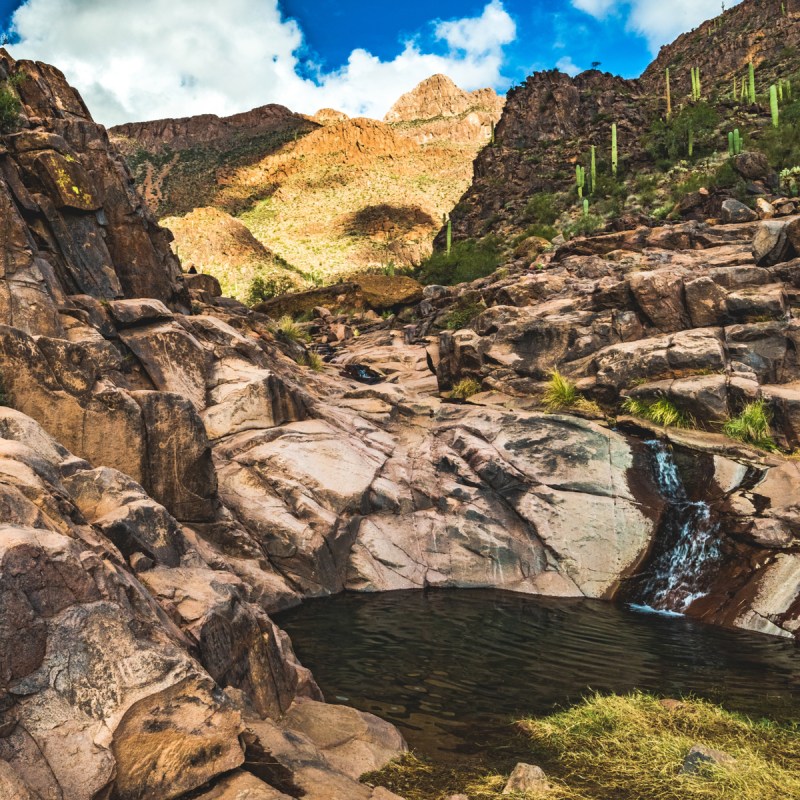
Though Arizona has been a U.S. state only since 1912, people have been living here for thousands of years. And people from ancient times have left signs of their existence, not only in cliff dwellings and other ruins throughout the state but also on the face of rocks scattered all over the desert. Arizona has a rich and ancient cultural history, and petroglyphs and other forms of rock art make up a record of the daily lives of ancient native civilizations of the area.
Videos by TravelAwaits
You can find thousands of petroglyphs and rock art sites in every corner of the state, from the center of Phoenix to the most remote areas. Some of these sites may have sacred meaning, others represent daily activities and surrounding nature, while others are so abstract scientists have not found their meanings yet. They all represent a glimpse into the past, an ancient art gallery we can enjoy in every corner of the state.
Created by removing the outer surface of rocks to reveal a lighter layer of the rock underneath, petroglyphs are the type of rock art that survives centuries. They are pictures or symbols left on rock surfaces by members of traditional cultures. Some of them date from tens of thousands of years ago, while others from a more recent past. They help archaeologists reveal some of the oldest histories in the world.
We are lucky in Arizona to have so many petroglyph sites. The following are only a few of them, including easily accessible and more spectacular ones, grouped by their proximity to each other and their origins.
1. Deer Valley Petroglyph Preserve, Glendale
An archaeological museum in the greater Phoenix area, the Deer Valley Petroglyph Preserve offers the best introduction to learning about petroglyphs. Run by Arizona State University, the preserve is also an archaeological center and museum, where visitors can learn about the petroglyphs and the indigenous people who created them.
Living relatively close to it, I’ve visited the preserve often over the years — and watched it grow from a small museum and trail to include more and more exhibits. They offer guided tours, lectures, and learning material, along with exhibits at the museum. Those who just want to see the petroglyphs can take the self-guided quarter-mile-long Petroglyph Trail.
Along the gravel walking path, interpretive signs and an audio tour offer insights into the cultures that created these petroglyphs, while also highlighting the desert ecology, putting the rock art collection into not only historical but also environmental context.
You can find the Deer Valley Petroglyph Preserve just two miles north of Hwy 101 in the North Phoenix/Glendale area, off the 27th Avenue exit.

2. Waterfall Trail In The White Tank Mountain, Wadell
About 30 miles farther west along the AZ-101, the White Tank Mountain Regional Park is also home to an abundance of petroglyphs, most of them created by the Hohokam, ancestors of the present-day Southern Arizona tribes, who lived in the area between 400 A.D. and the 1450s, though several are from archaic cultures that predate them.
The easiest way to see several of them is to take the Waterfall Trail. Just a few feet into the easy, mile-long trail, you’ll see a concentration of petroglyphs at Petroglyph Plaza. Signs in front of the petroglyph-filled boulders go into some detail about the prehistory of the park, offering a background to the images you see. Past Petroglyph Plaza, the trail narrows and becomes slightly steeper, and though other petroglyphs are harder to see, if you look, you can still find several on both sides of the trail all the way to the seasonal waterfall at the end.
You can find other petroglyph sites through the park, along the Black Rock Loop Trail, the Wadell, and Goat Canyon Trails. And, if you’d like to see more, even some not open to the public, you can take a ranger-led petroglyph hike, starting at the visitor center.

3. South Mountain Park And Preserve, Phoenix
Featuring over 16,000 acres of wilderness and over 50 miles of trails in the center of Phoenix, South Mountain Park and Preserve is one of the largest municipal parks in the U.S. Along with the unique desert wilderness, the park showcases and protects thousands of petroglyphs.
Most of these petroglyphs are the work of the Hohokam. Their villages were nearby, and archaeologists believe they used the mountains for hunting, gathering, and other resources. The mountains were most likely sacred to them, as they still are for their descendants, so the petroglyphs most likely marked important places and activities. They are representations of animals, birds, people, geometric shapes, and lines.
You’ll find petroglyphs along many of the trails in South Mountain, some easy and short, others strenuous and long. A few of the most easily accessible petroglyphs are along a short, flat trail off the Pima Canyon trailhead. Others are along the Judith Tunnel accessible trail, Telegraph Pass Trail, Kiwanis Trail, Mormon Loop Trail, Desert Classic, Mormon Trail, and Holbert Trail.
Pro Tip: Use a map when looking for the trails, since they may start at different trailheads, some far apart from each other, off different roads throughout Southern Phoenix. Don’t expect all the petroglyphs to be marked; however, most have a fence in front and a note asking visitors not to touch them.

4. Hieroglyphic Trail In The Superstition Mountains, Apache Junction
Not far from South Phoenix, the Hieroglyphic Trail in the Superstition Mountains takes hikers into the Hieroglyphic Canyon on the south side of the Mountains. The main petroglyph site is at the end of the trail, but if you take your time and look, you’ll find more along the way. Created by the same Hohokam, most of the rock art here represents sheep, deer, and desert bighorns, stick figures, and geometric shapes.
Pro Tip: This is a very popular trail, and it gets extremely busy, especially on weekends in the winter, and parking spots are limited. Opt to go on a weekday to avoid the crowds.

5. Picacho Mountains, Southern Arizona
Driving on Interstate I-10 from Phoenix toward Tucson, it is impossible to miss Picacho Peak, its unique shape towering above the surrounding desert along the road. While everyone who ever drove through his part of Arizona recognizes the 1,500-foot-tall peak, few people know that Picacho Mountain is home to one of the largest concentrations of petroglyphs in Arizona.
Archaeologists recorded over 4,000 petroglyphs in the Picachos, in clusters of over 12 different sites. The most spectacular ones are easy to access from a dirt road that traverses the state park. You’ll notice the first petroglyph site on the right side of the road as you drive in, on an immense pile of dark boulders. A clearing near the site offers a good parking spot.
Most of the petroglyphs in the Picachos are of Hohokam origin. However, archaeologists determined that some of them are much older, originating from Native Americans from the Archaic period who lived in the area between 8,000 B.C. and 400 A.D. These archaic glyphs are fainter and harder to see, though. The most recent glyphs are even more modern than the Hohokam ones, originating after the 16th century, and drawn by more modern tribes like the Pima.

6. Saguaro National Park West
Further south along I-10, Saguaro National Park is also home to a large number of petroglyphs, found in the West district of the park. Here, like at the sites listed above, most of the rock art was created by the Hohokam. They represent images of humans, animals, and astronomical objects and include abstract designs.
The largest petroglyph site in the park is the Signal Hill Petroglyph Site, on a rocky hill. Showcasing about 200 petroglyphs, the site is easy to access from a short trail near the Signal Hill picnic area along the Golden Gate dirt road.
Another easy-access petroglyph site in the park is along Kings Canyon Trail, about 1.5 miles up the trail. You’ll find the Kings Canyon trailhead across from the Desert Museum in a small parking area.

7. Petrified Forest National Park
Known for its large logs of petrified wood and its gorgeous desert vistas, Petrified Forest National Park is also home to one of the largest concentrations of petroglyphs in the state.
Newspaper Rock, an archaeological site within the park, showcases over 650 petroglyphs covering a group of large boulders within a small area. The large concentration of petroglyphs marks an archaeologically significant place.
The people who created these petroglyphs were the Ancestral Puebloans, ancestors of the modern Pueblo tribes, including the Hopi, Zuni, Acoma, and Laguna. The ancient artists who left their marks on these rocks lived along the Puerco River, some in the nearby Puerco Pueblo, about a mile north of the site. Many generations contributed to Newspaper Rock, so you won’t find a coherent story here. Interpretations of these petroglyphs include calendar events, family or clan symbols, territorial boundaries, and migratory routes as well as spiritual meanings.
Besides Newspaper Rock, you’ll find petroglyphs in the park at the archaeological site of Puerco Pueblo. Here, a 0.3-mile trail takes you along the remains of the village with perfect views of several well-preserved petroglyphs.

Petroglyph Sites That Require Permits Or A Guide To Visit
Several of the best Arizona petroglyph sites require permits or guides to visit.
Canyon de Chelly is home to a plethora of petroglyphs, and while it is possible to hike down into the canyon to the White House Ruins, to see petroglyphs along the sides of the canyon, you need to go with a local guide. We’ve done this several times over the years, and we’ve seen some spectacular petroglyphs left behind by the Ancestral Puebloans, also known as Anasazi, the ancient ones.
One of the largest petroglyph sites in Arizona, the Tutuveni Petroglyph Site is a Hopi site, though it is in the Navajo Nation, near Tuba City. Home to over 5,000 Hopi symbols, the glyphs relate to known historic and extinct Hopi tribal groups, dating from 1200 through the 1950s. Even though it is on the land of the Navajo Nation, the site is sacred for the Hopi, who use it as part of their children’s education about their ancestors, tribal traditions, and history. To ensure the site’s preservation, a permit is required to enter.
Tips For Viewing Petroglyphs
Besides the above sites, you can find petroglyphs all over Arizona, especially along desert trails. You’ll find them in Sedona, in Boynton Canyon, in Camp Verde, in Cave Creek, and along the trails in Spur Cross Conservation Area, just to name a few. Often you’ll come across them without warning as you walk along desert trails.
It is important not to get off the trails to get closer and touch them. The oils from your hands can damage the rock surfaces, and stepping on the rocks can dislodge petroglyph boulders or even the panels themselves.
Related Reading:
